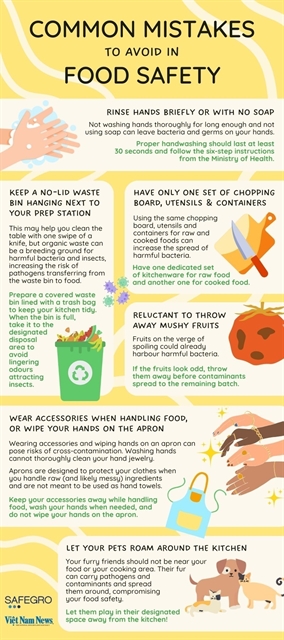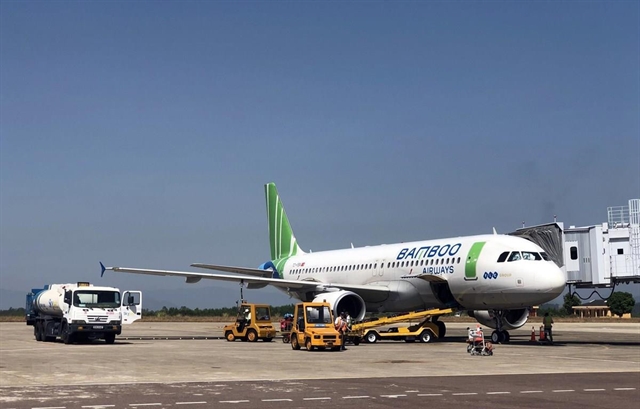 Society
Society

 |
| Nguyễn Văn Thuận, head of the Quality and Organic Agriculture Division at the National Authority for Agro-Forestry-Fishery Quality, Processing, and Market Development under the Ministry of Agriculture and Environment. — Photos courtesy of Nguyễn Văn Thuận |
The Safe Food for Growth (SAFEGRO) project is funded by the Government of Canada through a non-refundable grant of CAD15.3 million (over US$10.8 million). The Ministry of Agriculture and Rural Development, now known as the Ministry of Agriculture and Environment, serves as the project's executing agency. SAFEGRO is being implemented from 2020 to 2026 in collaboration with the Ministries of Health, Industry and Trade, and other relevant food safety agencies in Việt Nam.
Nguyễn Văn Thuận, a member of the project coordination unit and head of the Quality and Organic Agriculture Division at the National Authority for Agro-Forestry-Fishery Quality, Processing, and Market Development, shares valuable practical experiences and approaches to food safety management in Canada, gained during a recent study tour.
1. Food safety management system
Canada's food safety management system is a system of shared responsibility among government bodies at the federal and provincial/territorial levels, including: the Federal Government; provincial/territorial governments; local/regional public health authorities; international partners; businesses and consumers. Responsibilities are clearly delineated among federal-level agencies.
Ministry of Agriculture and Agri-Food implements food safety programmes at the primary production level (farms).
Health Canada develops policies and standards, and conducts risk assessments related to food safety.
Canadian Food Inspection Agency (CFIA) establishes procedures and regulations, and carries out inspections concerning food safety, animal diseases, animal health and welfare protection, plant pests, and plant protection. Founded in 1997, the CFIA brought together federal food inspection, animal health, and plant protection activities into a single enforcement agency. Its headquarters are in Ottawa, with 18 regional offices, 160 local offices, and 13 laboratories.
The Public Health Agency of Canada serves as the federal government's lead in assessing and addressing the human health impacts of foodborne illness outbreaks. It conducts public health surveillance and oversees epidemiological investigations when outbreaks affect more than one province.
The division of management responsibility and licensing between federal and provincial/territorial levels is determined by product distribution. Businesses trading products between provinces are inspected and licensed by the CFIA, whereas products sold exclusively within a province are inspected and licensed by the respective provincial or territorial authority.
Canada assigns food safety management and control responsibilities based on specific functional areas. For example, agencies responsible for developing policies, laws, regulations, and conducting risk assessments operate independently from those tasked with inspection.
2. Building food safety policies and laws
Canada has several acts related to food safety, including the Food and Drugs Act, Health of Animals Act, Plant Protection Act, and Plant Breeders' Rights Act, among others. These legal regulations establish a robust framework for food safety enforcement, clarifying and strengthening responsibilities in the process. The system aims to enhance food safety by ensuring Codex compliance—such as HACCP, preventive controls, and traceability—for imported, exported, and domestically consumed food. It promotes consistent, prevention-focused food safety requirements and adopts an outcome-based approach to encourage business innovation. Additionally, the use of incorporation by reference facilitates modernisation and efficiency, creating a level playing field for both domestic and imported food while improving market access.
Health Canada is responsible for establishing technical regulations, including Maximum Residue Limits (MRLs), which are issued as lists based on human health risk assessments. MRLs play a significant role in international trade; thus, Canada updates them periodically—every two years or as changes arise.
 |
| The Vietnamese delegation led by Mr. Nguyễn Văn Thuận (fifth from left) conducts a study tour to learn about Canadian practical experiences and approaches to food safety management. |
3. Implementation of food safety policies and laws
3.1. Food safety risk assessment
Health Canada leads this initiative by forming specialised risk assessment advisory groups and engaging a diverse range of scientific experts from research institutions, universities, and other organisations. The primary objectives of the risk assessment are to: develop comprehensive risk profiles to support information sharing and training programmes; create a robust database that serves as a foundation for effective risk management and control; and provide accurate data and insights to facilitate clear and impactful risk communication.
Risk assessment is seamlessly integrated with surveillance activities, facilitating the generation of risk profiles for information sharing and training, as well as the establishment of a database. This process defines the mandate for the CFIA. On such scientific bases, the agency performs the dedicated task of safeguarding food, animals, and plants, thereby enhancing the health and well-being of Canada's people, environment, and economy.
The risk assessment agency is recognised as a trusted partner and a global leader. It scientifically assesses food safety risks associated with all federally regulated domestic food establishments, characterizes these risks, considers their impact on consumer health in Canada, and operates transparently. Furthermore, resources are allocated and prioritized for implementation based on these assessments.
The risk assessment agency is recognised as a trusted partner and a global leader. It conducts rigorous scientific evaluations of food safety risks associated with all federally regulated domestic food establishments, characterises these risks, assesses their impact on consumer health in Canada, and ensures operational transparency.
3.2. Food safety risk communication
After the risk assessment results have been reviewed by appraisal committees/panels, risk communication is carried out publicly and transparently by Canadian authorities.
They compile all relevant risk assessment records to ensure comprehensive and accurate dissemination of information. This communication is carried out via official channels managed by the relevant authorities, as well as through credible, science-based press and media outlets.
3.3. Food safety risk management
The responsibility is managed by the CFIA. Canada's inspection system oversees not only food safety inspections but also matters concerning animal diseases, pests, and plant quarantine. Ensuring food safety involves a coordinated approach, integrating inspection data, surveillance, and the effective management of food safety concerns.
3.4. Food safety surveillance
Canada’s Food Safety Surveillance system systematically collects, analyses, and interprets data (information). This data is essential for assessing the effectiveness of food safety management practices, planning verification activities, and ensuring the timely dissemination of information to support public health initiatives.
The CFIA operates a structured surveillance cycle comprising key stages: Design, Sampling and Testing, and Reporting. The design of sampling plans undergoes thorough review, stakeholder consultation, and regular adjustments. Sampling plans have clear objectives, including: Targeted sampling (intentional sampling focused on a specific hazard and source), food safety incident response samples, and research samples. All surveillance results are documented and reported, with non-compliance findings prioritised for swift communication and dissemination to relevant parties.
The field trip revealed that Canada's approach to food safety is highly comprehensive, scientific, and effective. This includes its system for assigning responsibilities, its management hierarchy and control mechanisms for food safety, its legal and regulatory framework, and the enforcement of food safety laws and regulations.
Canada's food safety management system is guided by risk management principles, incorporating scientifically-grounded and practical measures. The division of authority and responsibilities between policy-making and law enforcement bodies is clear and well-defined. Notably, functional agencies execute their tasks with independence and objectivity, while ensuring integration, collaboration, and shared responsibility among relevant organisations. All of this is supported by an exceptionally high level of legal awareness among businesses and citizens./.




